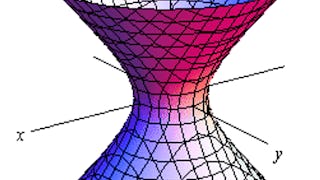This is the third course in the Honors Algebra 2 sequence. By the end of this course, students will be able to analyze, interpret, and apply advanced families of functions, including exponential, logarithmic, radical, and inverse functions. Learners will develop fluency in evaluating and graphing these functions, solving equations that involve them, and applying their properties to real-world models and predictions. Along the way, students will deepen their understanding of how different function types connect, building a stronger algebraic foundation for future courses in precalculus, calculus, and beyond.



Honors Algebra 2: Algebraic, Exponential & Log Functions
This course is part of Honors Algebra 2 Specialization

Instructor: Joseph W. Cutrone, PhD
Top Instructor
Access provided by UN Volunteers
Skills you'll gain
Details to know

Add to your LinkedIn profile
16 assignments
September 2025
See how employees at top companies are mastering in-demand skills

Build your subject-matter expertise
- Learn new concepts from industry experts
- Gain a foundational understanding of a subject or tool
- Develop job-relevant skills with hands-on projects
- Earn a shareable career certificate

There are 4 modules in this course
In earlier courses, you studied polynomials—functions built from whole-number powers of variables. In this module, we expand that perspective to functions with fractional powers, which represent nth roots and can also be written as radical expressions. Our focus will be on building a strong foundation in evaluating radical functions, graphing their behavior, and solving equations that involve them.
What's included
1 video4 readings4 assignments
We’ve already practiced creating new functions by translating and stretching the graphs of parent functions. In this module, we’ll explore even more ways to build new functions from existing ones. We'll begin by looking at how two functions can be combined to create a new one. Then, we’ll move on to explore inverse functions. Throughout the rest of the course, we’ll keep using these ideas to understand and work with different types of functions.
What's included
2 videos2 readings3 assignments
In this module, we explore two new types of functions that arise when modeling natural phenomena: exponential and logarithmic functions. For example, exponential functions are used to represent the growth of a population, the value of an investment, and the elimination of a drug from the body. Logarithmic functions are the inverses of exponential functions. We will start by examining the key features of these functions and their graphs, then look at algebraic rules to transform and solve equations with them. Finally, we will apply exponential and logarithmic functions to build models and make predictions.
What's included
5 videos4 readings5 assignments
For the last module of this course, we will explore rational functions, which arise naturally when modeling inverse variation. These functions are defined as quotients of polynomials. We will learn about the domain, range, and graphs of rational functions, and practice manipulating them with algebra. Finally, we will see how to solve rational equations.
What's included
2 videos3 readings4 assignments
Earn a career certificate
Add this credential to your LinkedIn profile, resume, or CV. Share it on social media and in your performance review.
Instructor

Offered by
Why people choose Coursera for their career




Explore more from Math and Logic

Johns Hopkins University

Johns Hopkins University

Johns Hopkins University

Johns Hopkins University

